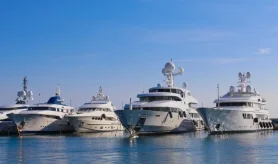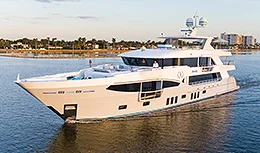- Alaskan Yachts
- Azimut Yachts
- Back Cove Yachts
- Beneteau Yachts
- Benetti Superyachts
- Bertram Yachts
- Boston Whaler
- Broward Yachts
- Buddy Davis Sportfish
- Burger Yachts
- Cabo Yachts
- Catamarans
- Carver Motoryachts
- Center Console
- Chris-Craft Yachts
- Cruisers Yachts
- DeFever Trawlers
- Dufour Sailboats
- Fairline Yachts
- Feadship Yachts
- Ferretti Yachts
- Filippetti Yachts
- Formula Yachts
- Fountaine Pajot Cats
- Grady-White
- Grand Banks Trawlers
- Hargrave Yachts
- Hatteras Yachts
- Hinckley Picnic Boats
- Horizon Yachts
- Hydra-Sports
- Intrepid Boats
- Jarrett Bay Sportfish
- Jeanneau Yachts
- Kadey-Krogen Trawlers
- Lazzara Yachts
- Lekker Boats
- Luhrs Sportfish
- Marlow Yachts
- Maritimo Yachts
- Marquis Yachts
- Mazu Yachts
- McKinna Motoryachts
- Meridian Yachts
- Midnight Express
- MJM Yachts
- Mochi Craft
- Neptunus Motoryachts
- Nordhavn Trawlers
- Nordic Tugs
- Numarine Yachts
- Ocean Alexander Yachts
- Ocean King
- Offshore Yachts
- Outer Reef
- Oyster Sailing Yachts
- Pacific Mariner Yachts
- Palmer Johnson Yachts

How Much Does It Cost to Charter a Yacht?
There are many elements to account for when considering the cost of a luxury yacht charter.
For travelers interested in seeing the world through chartering a yacht (or even just relaxing on one in their own figurative backyard), a common question is: what does it actually cost to charter a yacht? A number of variables can play a factor in this number, such as the yacht size, brand, type, length of stay, location, season, and more.
All of these elements can have a considerable impact on the price of chartering a yacht. However, all these items generally affect only the charter rate–which is just one piece of the puzzle when it comes to the total cost of a yacht charter.
Denison’s Charter Management Director in Europe, Nicolas Fry, expands on this. “At a basic level, chartering a yacht means paying a fee to rent out an owner’s superyacht for an agreed period of time with a pre-arranged itinerary of where you will be cruising on board. During a charter vacation, you will have access to all of the superyacht’s amenities, which could include a swimming pool, beach club, or cinema, as well as the toy box, which often provides equipment for water sports like wakeboarding, snorkeling, or water skiing. During charters, guests will be looked after by the yacht’s crew, who will take care of their every need, including ferrying them to and from shore, washing laundry, and providing meals cooked by the yacht’s chef.” But the costs of chartering a yacht don’t end there.
When looking at the cost to charter a yacht, there are a number of pieces to consider. Other than the charter rate, other costs are value-added tax (VAT), advance provisioning allowance (APA), crew gratuity, delivery fees, security deposits, and insurance.
Charter Rate

As mentioned, the charter rate (or charter fee) is the main price for chartering (or renting) the yacht itself. It includes the stay, accommodations, crew service (not to be mistaken for gratuity), use of water toys included on that specific charter yacht, and all the “basics”. This rate usually varies between high and low seasons–but not always–and summer and winter months. In the Mediterranean, in the summer, July and August are high charter rate months, while May, June, September, and October are the months that offer low charter rates. In the Caribbean, in the winter, only Christmas and New Year’s dates are times of high charter rates; the rest of the season offers low charter rates. Often there may be the same high and low rates for summer and winter, but in euros for summer and US dollars for winter in the Caribbean.
Of course, the Mediterranean summers and Caribbean winters are not the only cruising grounds, just the most common. There are also more adventurous locations, where charter rates do not follow such a traditional structure.
Check out this featured charter yacht: 166′ Yildizlar ARESTEAS
VAT (Value-Added Tax)

The value-added tax varies according to the country you are cruising in and can make a really significant difference to the end cost. For example, to charter in Italy there is a 22% tax, in France a 20% tax, and in Spain a 21% tax, but to charter in Croatia, there is only a 13% tax. Likewise, in the winter, there is now a total taxation in the Bahamas of 14%, but it is 0% in the very popular Leeward Islands of Antigua and St. Barths. “Looking at VAT is actually a really nice way to help clients work within their budget to make it stretch further,” says Denison Charter Specialist Caroline Antlett.
Check out this featured charter yacht: 133′ IAG SERENITY
Discover the top reasons to charter SERENITY here.
APA (Advance Provisioning Allowance)

APA is “the variable with the greatest fluctuation and also very much client-driven,” Caroline shares. It is usually 30-35% of the charter fee, unless otherwise specified. The charter fee includes the hire of the yacht, its insurance, as well as the crew’s wages and crew’s provisioning. All other expenses are considered extra and run per the charterer’s account.
Extras, to name a few, are the fuel and lubricants for the engines and generators, the fuel for the vessel’s tenders and motorized water toys, all beverages and food for the guests, local taxes, ashore transfers of the guests, use of the vessel’s communication systems by the guests, berthing fees and harbour dues, and special requirements–such as press and magazines, ashore laundry of personal items should it not be possible to launder those on board, flowers other than the welcome flowers, specific toiletry items, et cetera.
Although the client will have to pay an advance provisioning allowance (known, in short, as an APA) ahead of time, at the end of the charter the captain will present the client with a statement of accounts listing all the extras incurred during the charter. If the entire APA isn’t spent, the charterer will be refunded the remaining balance. On the other hand, should the APA not suffice to cover all expenses, the charterer will have to settle the difference.

Sometimes, the APA is fully spent before the charter comes to an end. In those instances, the captain will ask the charterer to top it up. Logically, the amount spent in extras might vary based on the charterer’s wishes, such as the number of nights in port versus nights at anchor, brands/vintages/types and quantity of wines and other alcoholic beverages, type of food, number of hours cruising, and more. A good captain will keep the client updated with how the APA spend is going, so the client is not suddenly faced mid-charter with no more APA funds, and so they can continue to make their choices in an informed manner.
Caroline adds an important note: the vessel might be forced to enter a port due to adverse weather conditions or if they can’t refuel, provision or fill the water tanks because the port where they have to do this doesn’t have a waiting quay free of charge. The port fees charged in these types of instances must also be assumed by the charterer.
“Over the past 12 months,” Caroline continues, “we have seen fuel prices driven up massively, and as fuel for the yacht, tenders, and toys makes up a significant cost from the APA, this has had a real effect on charter prices to clients overall. Again, this is where the value of a charter broker can come in, so if the budget is less flexible, we can be sure to recommend yacht builds with lower fuel consumption. Another nice thing to do is to show clients the fuel consumption for different itineraries to help them factor this into their choices so they don’t get blindsided mid-way through the charter or at the end.”
Check out this featured charter yacht: 157′ Rades Blato CORSARIO
Get to know the crew aboard charter yacht CORSARIO here.
Crew Gratuity (Tip)

The charter fee doesn’t include the gratuity for the crew either, as alluded to earlier. Whether or not to leave a tip as well as the amount, remains at the charterer’s sole discretion. As a rule of thumb, in the Mediterranean, tips range from 10% to 20% based on the level of satisfaction with the service received. American clients are known for being much more open to higher tips than Europeans. The crew is responsible for a large part of guests’ enjoyment and satisfaction, and to many guests become like family during their luxury vacation. For this reason, it is always nice when charterers show their gratitude with crew gratuity.
Check out this featured charter yacht: 131′ Sunseeker ACACIA
Discover the top five reasons to charter ACACIA here.
Delivery Fee

A delivery fee is usually charged if a charterer requests to board (or depart) a yacht at a different location than where the yacht is normally based. The fee is based on the distance and fuel cost to bring the yacht from its home port to the embarkation port (delivery fuel). Some owners will also charge a delivery time, calculated on the time of cruising between the two ports.
Check out this featured charter yacht: 135′ W.A. Souter & Sons SEA LADY II
Security Deposit

A security deposit is generally payable for corporate charters or when bringing pets on board. The security deposit, much like with a home rental, is the amount for which a charterer is liable in case of any damage that is the consequence of mishandling the boat, which may happen during the charter. The security deposit is refunded in its full amount when the charter is over unless damage or some defect on the yacht or the equipment is found during the charter.
Check out this featured charter yacht: 116′ Hargrave ROMEO FOXTROT
Discover the top five reasons to charter ROMEO FOXTROT here.
Insurance

One cost that is not directly related to the operation of the charter is insurance for the charterer. Cancellation and curtailment insurance is the charter version of travel insurance for airlines and cruise ships: it covers the charterer if unforeseen circumstances force a cancellation or shortening of the charter. A charter broker can provide this type of insurance, which is a wise investment for anyone considering a yacht charter vacation.
Check out this featured charter yacht: 131′ Princess LE VERSEAU
According to averages taken from BOAT International’s listings, Nicolas shares, smaller superyachts measuring under 30 meters LOA will have a weekly charter rate somewhere around €40,000, while yachts between 30 and 40 meters will weigh in at an average of €70,895 per week. Over 40 meters, the charter rate will move into the €100,000 per week range, with yachts between 50 and 60 meters costing on average €219,826 per week, while yachts in the 60- to 70-meter range average €444,521. Megayachts measuring 80 meters and over will, on average, set charterers back by around €1.7 million a week. This is just an average price, however, and each yacht’s charter rate will be affected by a number of aspects, ranging from how many cabins and amenities there are on board to the dates and locations of where the charter will take place.
Interested in booking a charter for your next vacation? Contact a Denison charter broker for more information.






